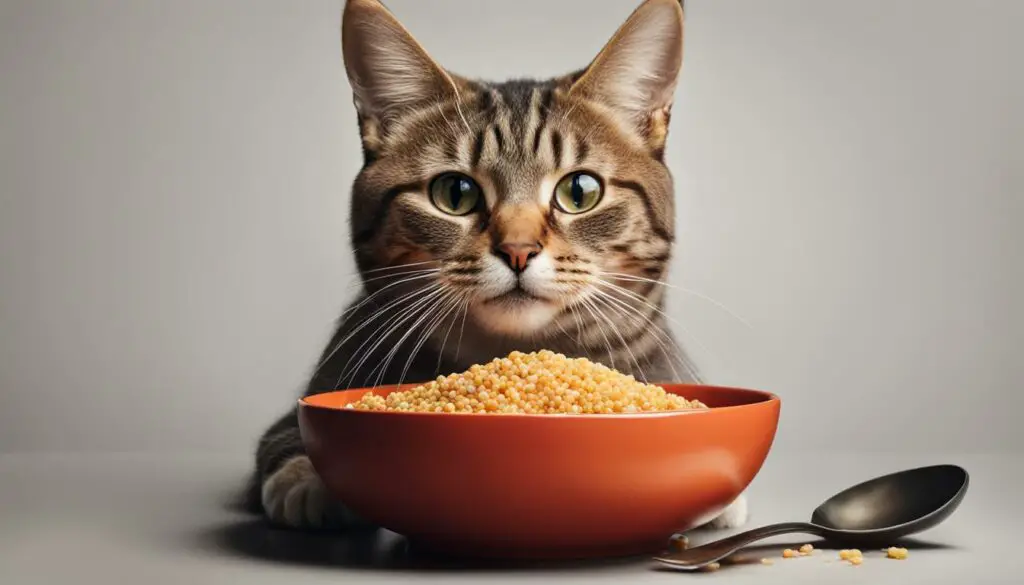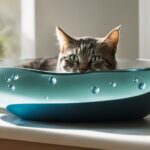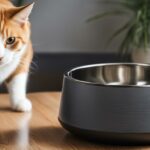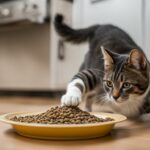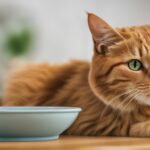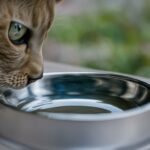When it comes to choosing the right bowl for your beloved feline friend, safety should be your top priority. Ceramic bowls have gained popularity among cat owners, but are they truly safe? Let’s take a closer look at the truth behind ceramic bowls for cats.
Ceramic bowls can be a viable option for feeding your cat, but it’s essential to understand the potential risks associated with them. Your cat’s health and well-being should never be compromised, so let’s delve into the important factors to consider when it comes to choosing the right cat bowl.
Key Takeaways:
- Ceramic bowls can be a safe choice for cats when used correctly.
- Ensure that the ceramic bowl is labeled as “lead-free” and “food safe”.
- Avoid glazed ceramics that may contain toxic substances like lead and cadmium.
- Check for any chips or cracks that could increase the risk of ingestion.
- Consider non-toxic alternatives like glass and stainless steel if you have concerns about ceramic bowls.
The Importance of Bowl Material for Cat Safety
When it comes to choosing a bowl for your cat, the material used is of utmost importance to ensure their safety. Certain materials, such as plastic, can pose potential risks due to their porous nature and the possibility of chemical leaching. That’s why it’s crucial to opt for non-toxic materials like ceramic, which can be a suitable choice if used correctly.
Ceramic bowls are favored by many cat owners for a variety of reasons. They are generally free from harmful substances and are resistant to scratches, making them easier to clean and maintain. However, it’s important to note that not all ceramic bowls are created equal. It’s essential to look for bowls labeled as “lead-free” and “food safe” to avoid any potential health hazards associated with glazes containing toxic substances like lead and cadmium.
Another factor to consider with ceramic bowls is the presence of any chips or cracks. These imperfections can increase the risk of ingestion, especially if they occur in areas where food or water is placed. Regular inspection of ceramic bowls and immediate replacement of any damaged ones is crucial to ensure the safety of your cat.
To summarize, the material of a cat bowl plays a significant role in their safety. Ceramic bowls can be a viable option when they are lead-free, food-safe, and free from any chips or cracks. By choosing the right bowl material, you can provide your feline companion with a safe and enjoyable feeding experience.
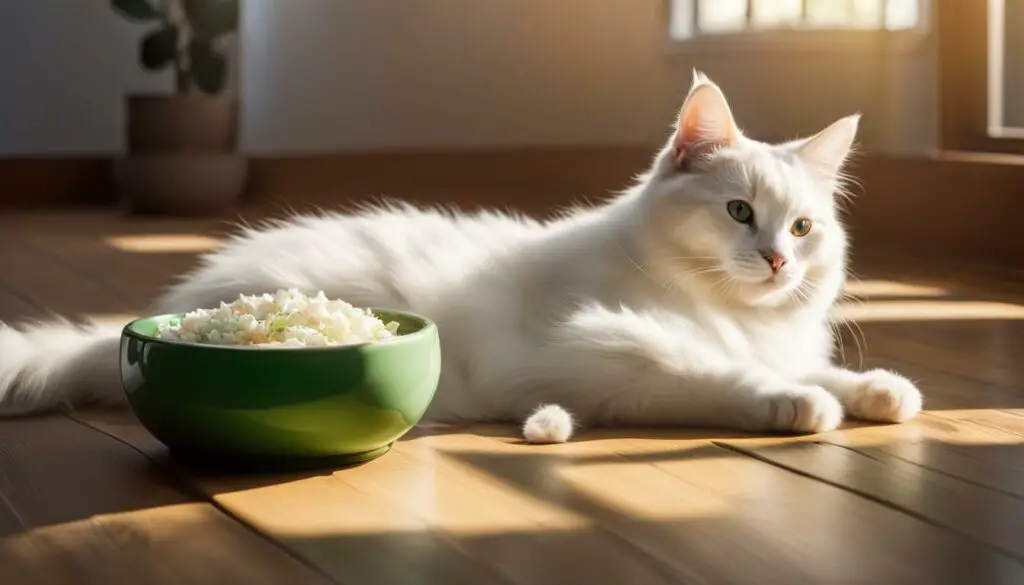
The Importance of Bowl Material for Cat Safety
The Safest Materials for Cat Food Bowls
When it comes to choosing the right food bowl for your cat, the material it’s made of plays a crucial role in ensuring their safety and wellbeing. Two of the safest materials for cat food bowls are glass and stainless steel. Let’s take a closer look at why these materials are recommended over others:
Glass Cat Food Bowls
Glass cat food bowls are an excellent choice for several reasons. Firstly, glass is a non-toxic material that won’t leach any harmful chemicals into your cat’s food or water. It is also non-reactive, which means it won’t interfere with the taste or quality of the food. Additionally, glass bowls can be easily sterilized, making them a hygienic option for your furry friend.
Stainless Steel Cat Food Bowls
Stainless steel is another safe and durable material for cat food bowls. It is impermeable, meaning it won’t absorb any bacteria or odors. Stainless steel bowls are also easy to clean and dishwasher safe, making the maintenance a breeze. Furthermore, they are resistant to scratching, which reduces the risk of bacteria buildup.
Both glass and stainless steel cat food bowls are free from the potential health risks associated with plastic bowls, such as chemical leaching and bacterial contamination. By opting for these safe materials, you can provide your cat with a clean and healthy feeding experience.
| Advantages of Glass Cat Food Bowls | Advantages of Stainless Steel Cat Food Bowls |
|---|---|
| Non-toxic | Impermeable |
| Non-reactive | Easy to clean |
| Sterilizable | Scratch-resistant |
When considering the safety of your cat’s food bowl, it’s essential to prioritize non-toxic materials like glass and stainless steel. These materials not only provide a clean and hygienic feeding environment but also offer long-lasting durability. By investing in a high-quality cat food bowl, you can ensure your furry companion enjoys their meals in the safest way possible.
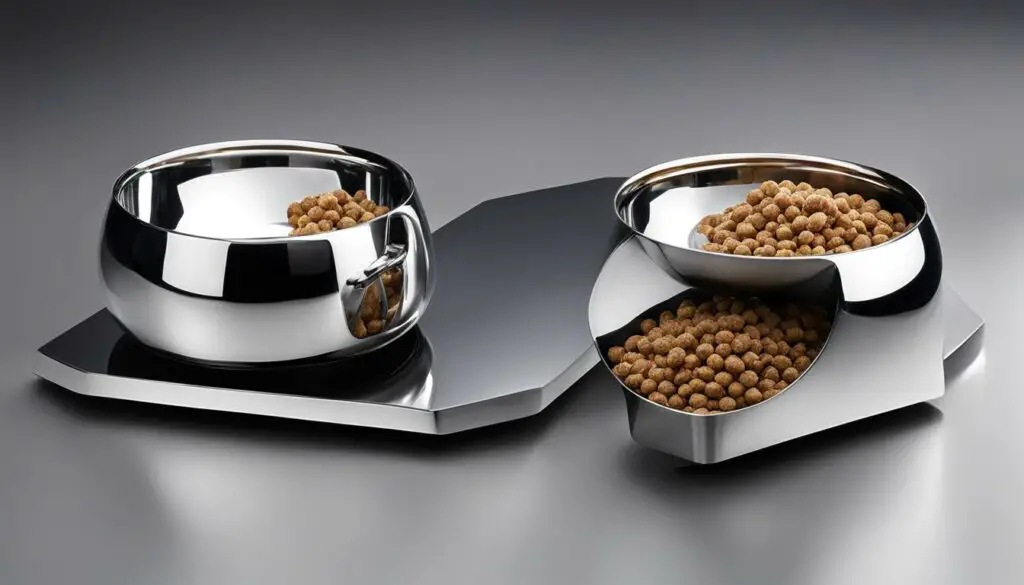
Ceramic Bowls – A Viable Option with Caveats
When it comes to choosing bowls for your cat, ceramic bowls can be a safe and attractive option. However, it’s important to exercise caution and be aware of certain caveats.
Ceramic cat dishes can be a suitable choice due to their durability, non-toxic nature, and aesthetic appeal. They are typically made from lead-free ceramic that is labeled as “food-safe.” These bowls offer a stable and comfortable eating surface for your feline friend.
However, it’s crucial to check the quality of the ceramic bowl before purchasing. Look for any cracks or chips that may increase the risk of ingestion and potential injury. Additionally, avoid glazed ceramic bowls that may contain toxic substances like lead or cadmium. These can pose serious health risks to your cat.
Choosing the right ceramic bowl for your cat is crucial. Look for bowls that are labeled as “lead-free” and “food-safe.” Avoid glazed ceramics that may contain toxic substances like lead and cadmium. Check for any chips or cracks that could increase the risk of ingestion.
To ensure the safety of your cat, it’s recommended to regularly inspect and clean ceramic bowls. Wash them with soap and water after each use, and if possible, sterilize them in the dishwasher. This helps maintain a hygienic eating environment and reduces the risk of bacterial growth.
| Pros of Ceramic Bowls | Cons of Ceramic Bowls |
|---|---|
| Ceramic bowls are durable and long-lasting. | Glazed ceramics may contain toxic substances like lead or cadmium. |
| Ceramic bowls are non-toxic when labeled as “lead-free” and “food-safe.” | Cracks or chips in ceramic bowls can increase the risk of injury and ingestion. |
| Ceramic bowls offer an aesthetic appeal and come in various designs. | Regular inspection and cleaning are necessary to maintain hygiene. |
Overall, ceramic bowls can be a viable option for feeding your cat, but it’s essential to choose carefully and prioritize their safety. By selecting lead-free and food-safe ceramic dishes, and regularly inspecting and cleaning them, you can provide your furry friend with a safe and enjoyable dining experience.
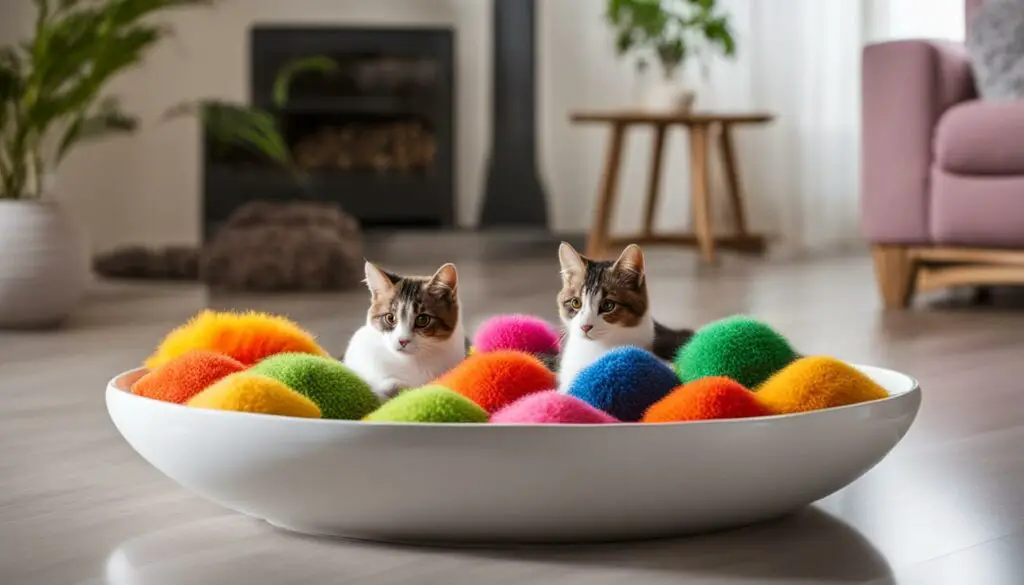
The Dangers of Plastic Bowls for Cats
When it comes to choosing cat bowls, plastic may seem like a convenient and affordable option. However, it’s important to be aware of the potential dangers that plastic bowls can pose to your feline friend. Plastic cat food and water bowls can harbor bacteria, potentially leading to health issues for your cat.
One of the main concerns with plastic bowls is that they are porous and easily scratched. These scratches can provide a breeding ground for bacteria, even after washing the bowls. Additionally, if the plastic is made with harmful chemicals like BPA (bisphenol A) or phthalates, it can leach into your cat’s food or water, posing a risk to their health.
Plastic bowls can also contribute to feline acne and skin allergies. The rough surface of plastic can irritate your cat’s skin, leading to breakouts and discomfort. Switching to non-toxic materials like glass or stainless steel can help alleviate these issues and provide a safer feeding experience for your furry friend.
Overall, it is best to avoid plastic cat bowls due to their potential health hazards. By opting for non-toxic alternatives like glass or stainless steel, you can ensure the safety and well-being of your beloved cat.
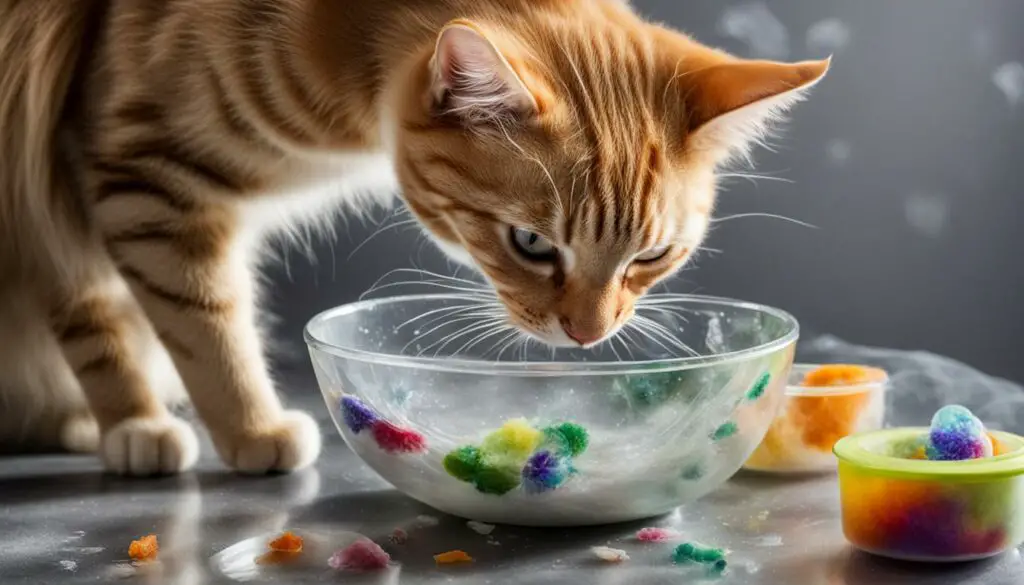
Proper Care and Cleaning of Cat Bowls
When it comes to keeping our furry friends healthy, proper care and cleaning of their feeding bowls are of utmost importance. Regular cleaning helps prevent the growth of bacteria and maintains your cat’s well-being. Let’s take a look at some essential tips for keeping cat bowls clean and germ-free.
Washing Cat Bowls
The first step in maintaining clean cat bowls is washing them thoroughly after each use. Using warm water and mild soap, gently scrub the bowls to remove any leftover food particles or residue. Pay extra attention to the crevices and corners where bacteria can hide. Rinse the bowls thoroughly to ensure no soap residue remains.
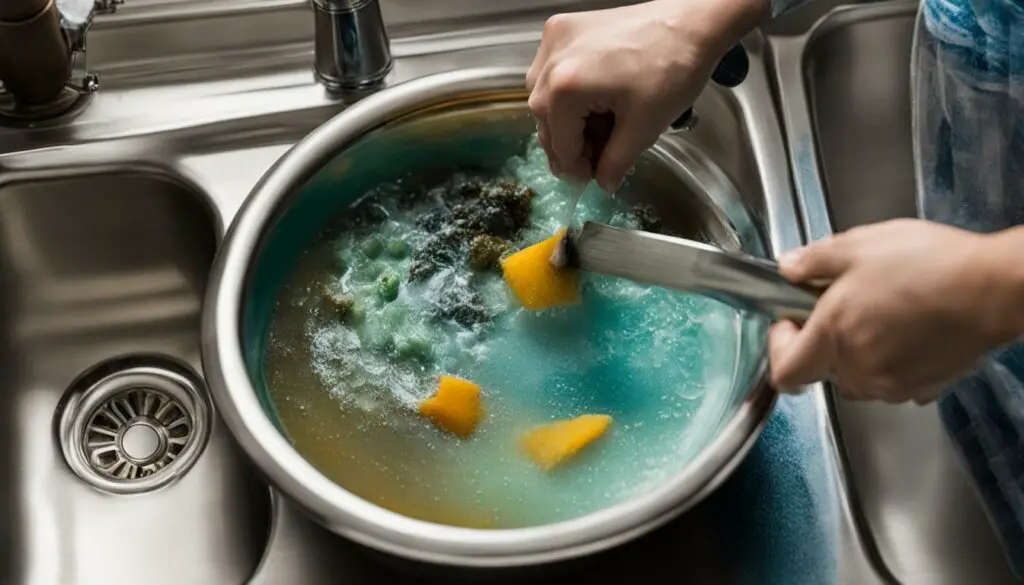
Sterilizing Cat Bowls
In addition to regular washing, it’s important to sterilize cat bowls to ensure maximum cleanliness. Wet food bowls should be placed in the dishwasher at least 3-4 times per week or even daily if possible. The high temperatures and strong detergents used in dishwashers effectively kill bacteria and sanitize the bowls. Dry food bowls can be sterilized by pouring boiling water over them and allowing them to air dry.
Preventing Cross-Contamination
When it comes to feeding multiple cats or offering different types of food, it’s crucial to prevent cross-contamination. Each cat should have their designated bowl, and these bowls should not be used interchangeably. This practice helps reduce the risk of spreading potential illnesses or allergies. Additionally, avoid using the same sponge or cloth used for cleaning cat bowls on other utensils or surfaces to prevent cross-contamination in your kitchen.
By following these simple guidelines, you can ensure that your cat’s bowls are clean, safe, and free from harmful bacteria. Remember to wash, sterilize, and prevent cross-contamination to maintain your beloved feline’s health and well-being.
Choosing Non-Toxic Alternatives for Cat Dishes
When it comes to selecting dishes for your beloved feline, it’s important to prioritize their safety and well-being. While ceramic bowls can be a viable option, there are non-toxic alternatives available that provide peace of mind. Consider materials like glass and stainless steel, which have been proven safe for cats and are widely recommended by veterinarians.
When selecting non-toxic cat dishes, it’s crucial to look for products that are certified for food usage. This ensures that the materials used are free from harmful substances and are safe for your cat to eat from. Additionally, choose dishes that are labeled as lead safe, as lead can be toxic to cats if ingested.
“I always prioritize the health and safety of my furry friend, which is why I opt for non-toxic dishes made from glass or stainless steel,” says pet owner Samantha.
“It gives me peace of mind knowing that the materials are safe, and I can focus on providing the best care for my cat.”
By selecting non-toxic cat dishes, you are taking a proactive step in ensuring the health and well-being of your cat. These dishes are durable, easy to clean, and provide a safe and hygienic feeding experience. Remember to research reputable brands and avoid products that may contain harmful substances. Your cat’s safety is paramount, and choosing non-toxic dishes is a simple yet impactful way to prioritize their health.
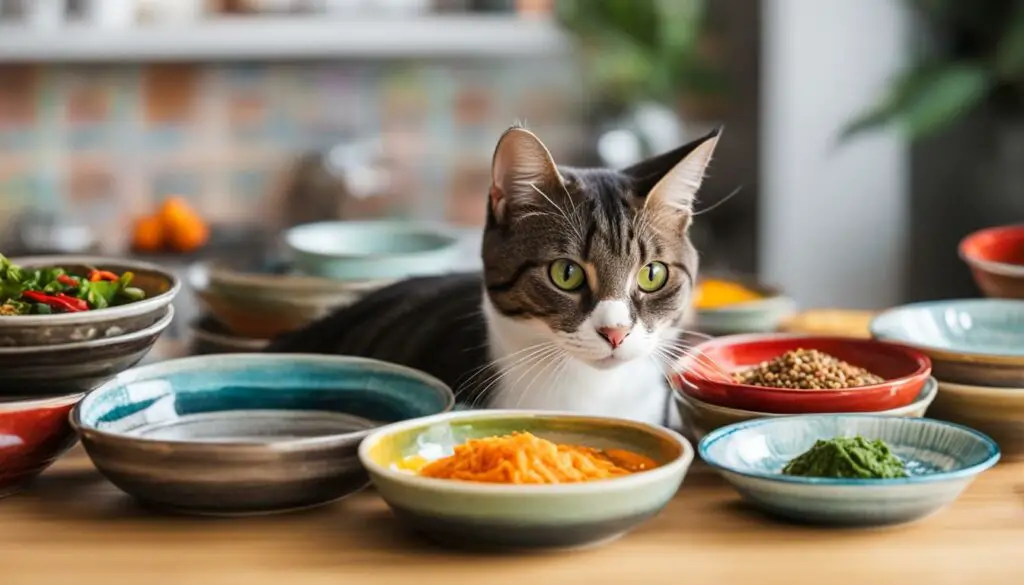
| Non-Toxic Cat Dishes | Material | Benefits |
|---|---|---|
| Glass | Non-reactive, sterilizable | Non-toxic, easy to clean |
| Stainless Steel | Impermeable, germ-resistant | Durable, safe for cats |
Benefits of Ceramic Pet Dishes
When it comes to choosing the right dish for your cat, ceramic pet dishes offer several advantages. Not only are they durable and long-lasting, but they are also environmentally friendly and can be a safe option for feeding your feline friend. Ceramic dishes are made from natural materials, making them non-toxic when made with lead-free glazes. This ensures that your cat’s food and water are not contaminated by harmful substances.
One of the key benefits of ceramic pet dishes is their durability. Unlike plastic or other materials that may crack or break easily, ceramic dishes are sturdy and resistant to damage. This means that they can withstand daily use and won’t need to be replaced as frequently, making them a cost-effective choice in the long run.
Additionally, ceramic pet dishes are available in a variety of designs and colors, allowing you to choose one that matches your home decor while providing a pleasant dining experience for your cat. Their weight also prevents them from being easily tipped over, ensuring that the food and water stay in the bowls and not all over your floor.
Table: Comparison of Ceramic Pet Dishes
| Benefits | Ceramic Pet Dishes | Plastic Pet Dishes | Stainless Steel Pet Dishes |
|---|---|---|---|
| Durability | Durable and long-lasting | Prone to cracking and breaking | Durable and resistant to damage |
| Non-Toxic | Lead-free glazes, non-toxic materials | May contain harmful chemicals like BPA | Non-reactive and safe for food |
| Environmental Impact | Made from natural materials | Non-biodegradable and harmful to the environment | Non-biodegradable but recyclable |
| Aesthetics | Available in various designs and colors | Limited design options | Simple and sleek design |
Overall, ceramic pet dishes can be a great choice for feeding your cat. However, it’s essential to ensure that the glaze used on the bowl is lead-free to prevent any potential health risks. Regular cleaning and inspection for any chips or cracks will also help maintain the safety and longevity of the dish. With their durability, non-toxic nature, and aesthetically pleasing designs, ceramic pet dishes provide a safe and enjoyable dining experience for your beloved feline companion.
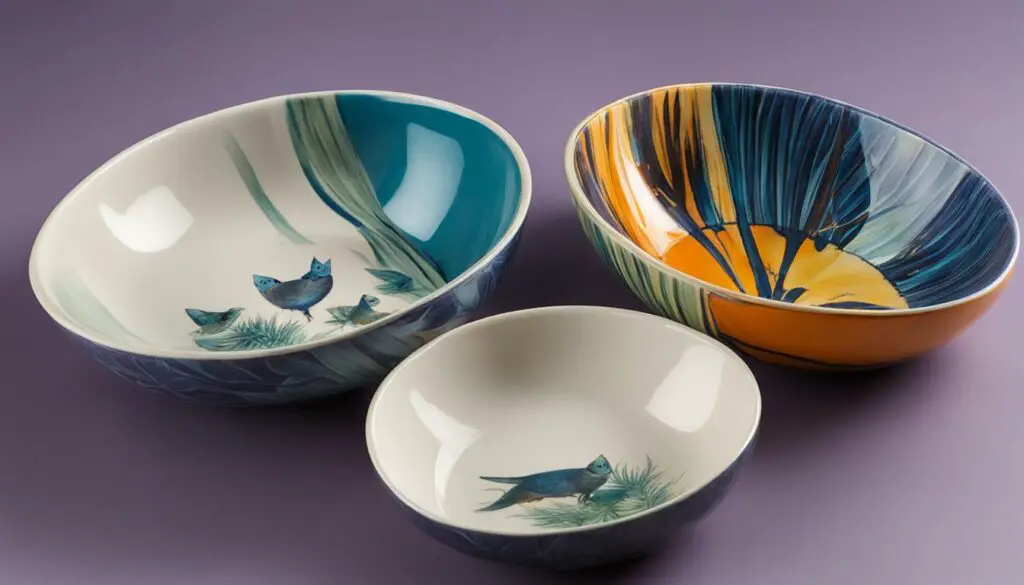
Considerations with Stoneware Pet Bowls
Stoneware pet bowls are a popular choice for many pet owners due to their durability and aesthetic appeal. However, it’s important to be aware of potential concerns regarding lead levels in some stoneware products. Testing has shown that a significant percentage of stoneware pet bowls contain detectable levels of lead, which may exceed safety standards.
When choosing stoneware pet bowls, it’s crucial to research and select products carefully. Look for bowls that are specifically labeled as lead-free and meet safety standards. Additionally, consider purchasing from reputable brands or manufacturers that prioritize pet safety and adhere to strict quality control measures.
To further minimize the risk of lead exposure, you can also opt for alternative materials like glass or stainless steel. These materials have been proven safe for pets and do not pose the same concerns as stoneware. By prioritizing the safety and well-being of your furry friend, you can ensure they have a healthy and enjoyable dining experience.
| Pros of Stoneware Pet Bowls | Cons of Stoneware Pet Bowls |
|---|---|
| 1. Durable and long-lasting. | 1. Some stoneware bowls may contain detectable levels of lead. |
| 2. Aesthetic appeal and variety of designs. | 2. Risk of lead exposure if the bowl is not labeled as lead-free. |
| 3. Can keep food and water cool for longer periods. | 3. Potential safety concerns if the bowl is chipped or cracked. |
While stoneware pet bowls can be a suitable option, it’s crucial to weigh the pros and cons and make an informed decision. Consider the safety of your pet as the top priority and choose bowls that are certified as lead-free and meet rigorous quality standards. Regularly inspect the bowls for any signs of damage and replace them if necessary to ensure your pet’s health and well-being.
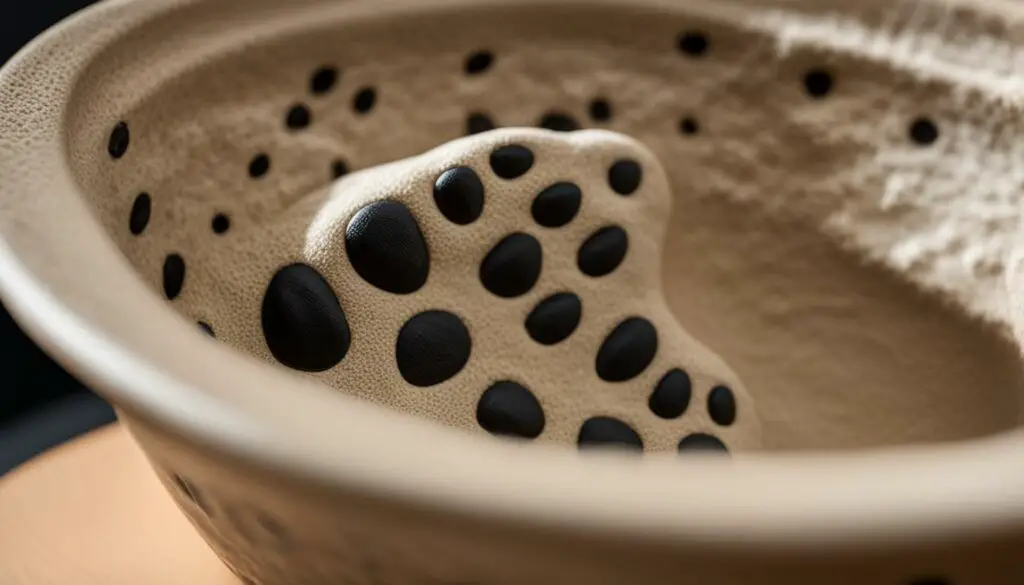
Exploring Silicone Pet Dishes
When it comes to choosing pet dishes, silicone can be a viable option for cat owners looking for non-toxic and versatile alternatives. Silicone pet dishes are made from a flexible and durable material that is safe for cats. These dishes are nonstick, heat-resistant, and can be easily cleaned in the dishwasher, making them convenient for pet owners.
Silicone pet dishes offer several benefits, including their lightweight and portable nature. They are great for traveling or taking on outdoor adventures with your cat. The flexibility of silicone also means that these dishes can be folded or collapsed for easy storage when not in use.
Silicone pet dishes offer a non-toxic option for feeding your cat. They are nonstick, heat-resistant, and can be easily cleaned in the dishwasher.
However, it’s important to note that silicone dishes may not be as rigid as other materials, making them less suitable as permanent pet dishes. Some cats may find it easier to move or tip over silicone dishes due to their flexibility. If your cat tends to be more active or playful during mealtime, you may want to consider a sturdier option like stainless steel or ceramic.
In conclusion, if you’re looking for a non-toxic and convenient option for feeding your cat, silicone pet dishes can be a great choice. Just be mindful of your cat’s behavior and consider their specific needs when selecting the right dish. Whether you choose silicone, stainless steel, or ceramic, prioritize the safety and comfort of your beloved feline companion.
![]()
Advantages of Silicone Pet Dishes:
- Non-toxic and safe for cats
- Nonstick and easy to clean
- Heat-resistant and durable
- Lightweight and portable
Disadvantages of Silicone Pet Dishes:
- Less rigid than other materials
- May be easier to move or tip over
- Not suitable as permanent pet dishes for more active or playful cats
Finding Non-Toxic Pet Dishes
When it comes to keeping our furry friends safe, choosing non-toxic pet dishes is of utmost importance. By selecting the right materials for their feeding bowls, we can provide a healthier and safer environment for our beloved pets.
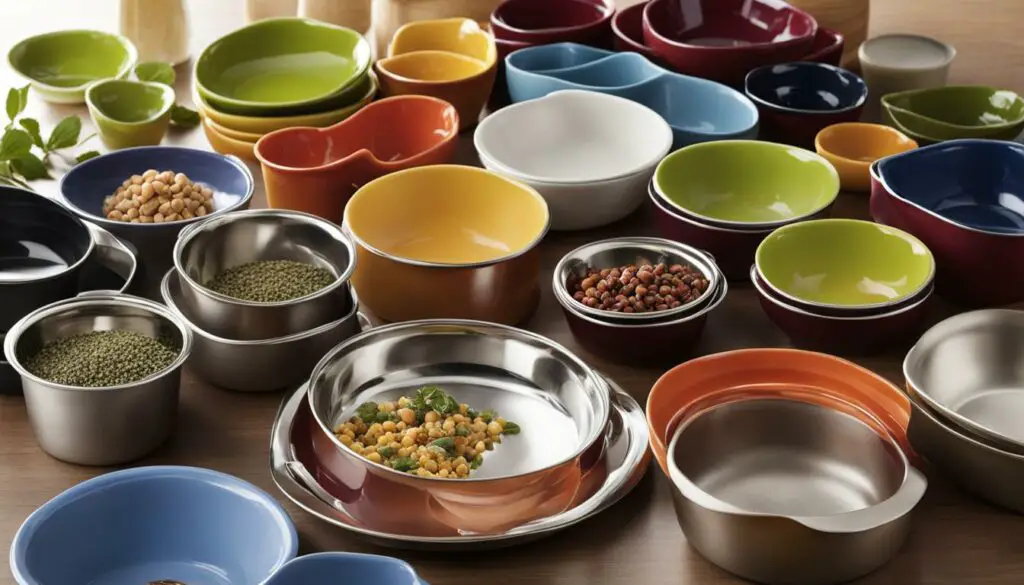
If you’re in the market for non-toxic pet dishes, it’s crucial to do your research and make informed choices. Look for products that are certified for food usage and manufactured in the United States, as they often have higher safety standards. Avoid products that may contain harmful substances such as lead or other toxic materials.
Choosing lead-safe pet dishes is particularly important, as lead can have detrimental effects on your pet’s health. Lead exposure can lead to various health issues, including neurological and developmental problems. By selecting lead-safe options, you can minimize the risks and ensure the well-being of your furry friend.
Key Considerations for Non-Toxic Pet Dishes:
- Look for pet dishes certified for food usage and manufactured in the United States.
- Avoid products that may contain harmful substances like lead or other toxic materials.
- Consider lead-safe pet dishes to minimize health risks.
| Material | Non-Toxic | Lead Safe |
|---|---|---|
| Glass | ✔ | ✔ |
| Stainless Steel | ✔ | ✔ |
| Ceramic (lead-free) | ✔ | ✔ |
| Plastic | No | No |
By following these guidelines and understanding the importance of non-toxic pet dishes, you can create a safe and healthy feeding environment for your furry companion.
Factors to Consider When Choosing Cat Bowls
When it comes to choosing cat bowls, there are several factors that you should consider to ensure the well-being and safety of your feline companion. The material of the bowl plays a crucial role in maintaining your cat’s health, as certain materials can pose risks. Additionally, factors such as durability, ease of cleaning, and size should also be taken into account.
The first and most important factor to consider is the material of the cat bowl. Opt for non-toxic materials like glass or stainless steel, as they are safe for cats and do not leach harmful chemicals. Glass is non-reactive and can be sterilized, while stainless steel is impermeable and resistant to bacteria. These materials are recommended over plastic, which can harbor bacteria and contain potentially harmful substances.
Another factor to consider is the durability of the cat bowl. Cats can be quite rough with their dishes, so choosing a bowl that is sturdy and long-lasting is essential. Ceramic bowls can be a good option in terms of durability, but it’s crucial to ensure that the glaze used is lead-free and food safe. Avoid bowls with any chips or cracks, as they can increase the risk of ingestion.
Lastly, consider the size and ease of cleaning of the cat bowl. Choose a bowl that accommodates the appropriate portion size for your cat’s meals. It should be easy to clean and dishwasher safe, allowing for thorough sterilization. Regular cleaning is important to prevent the growth of bacteria and maintain your cat’s health.
In conclusion, choosing the right cat bowl is crucial for your cat’s health and well-being. Consider factors such as material safety, durability, and ease of cleaning when making your selection. Opt for non-toxic materials like glass or stainless steel, ensuring they are labeled as food safe. By prioritizing these factors, you can provide your cat with a safe and enjoyable dining experience.
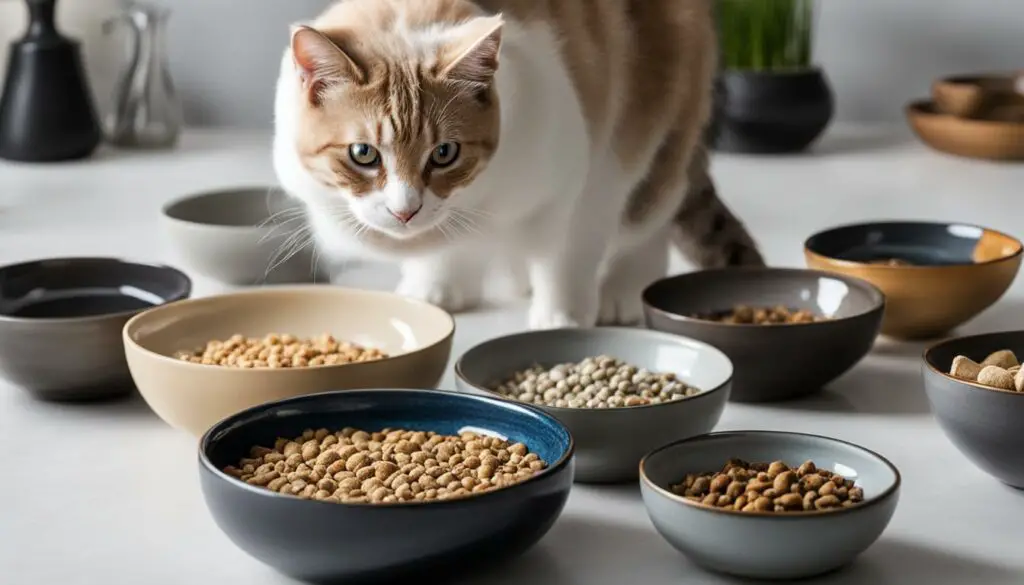
The Importance of Quality Cat Food
Choosing the right cat food is essential for maintaining your feline companion’s health and well-being. High-quality cat food not only provides the necessary nutrients but also supports overall growth and development. It’s important to consider several factors when selecting cat food, including the ingredients, nutritional value, and specific dietary needs of your cat.
When choosing cat food, look for brands that use real meat as the primary ingredient. Cats are obligate carnivores, meaning they require a diet rich in animal protein. Avoid products that contain fillers, by-products, or artificial additives, as these can be detrimental to your cat’s health. Reading the label carefully and understanding the nutritional value will help ensure that your cat receives the necessary nutrients.
It’s also crucial to consider any specific dietary needs your cat may have. Some cats may require a specialized diet due to medical conditions such as allergies, gastrointestinal issues, or urinary tract problems. Consulting with a veterinarian can help you identify any specific dietary requirements your cat may have and guide you towards the most suitable food options.
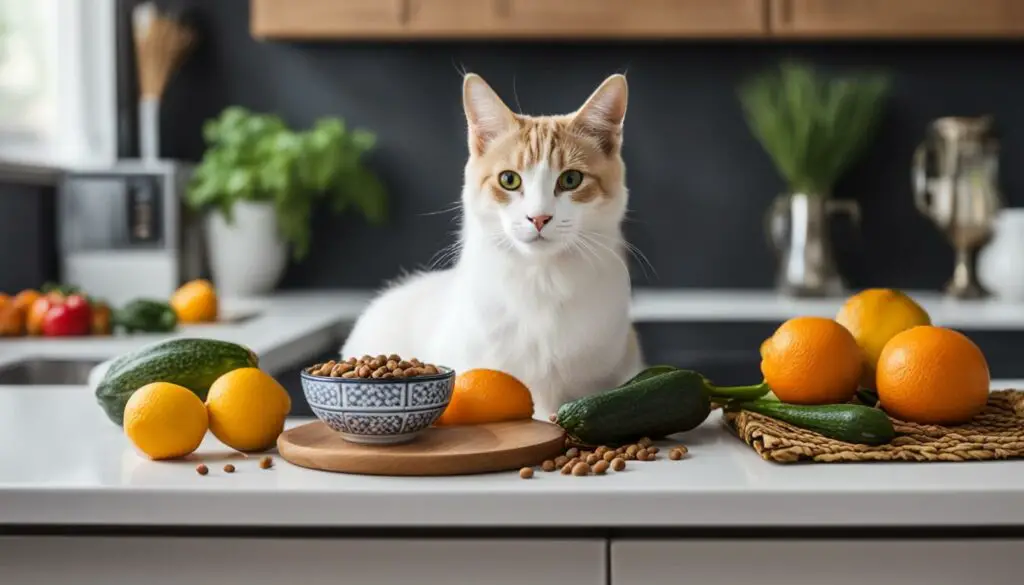
The Role of Nutrients in Cat Food
Cat food should contain a balance of essential nutrients to support your cat’s overall health. These include proteins, fats, carbohydrates, vitamins, and minerals. Proteins are crucial for muscle development and provide the necessary amino acids. Fats provide energy and support healthy skin and coat. Carbohydrates supply energy, while vitamins and minerals play a vital role in various bodily functions.
When selecting cat food, be mindful of the specific nutrients it provides. Look for products that meet the standards set by reputable organizations such as the Association of American Feed Control Officials (AAFCO). These standards ensure that the food contains the necessary nutrients to meet your cat’s requirements at different stages of life.
In conclusion, choosing high-quality cat food is essential for your cat’s overall health and well-being. Consider the ingredients, nutritional value, and any specific dietary needs your cat may have. By providing your feline companion with a nutritious diet, you can help them lead a happy and healthy life.
Essential Cat Accessories for a Happy Cat
When it comes to providing a comfortable and enriched environment for your feline friend, a few essential cat accessories can make all the difference. From grooming tools to scratching posts and litter boxes, these items cater to your cat’s natural instincts and contribute to their overall well-being.
Grooming Tools
Grooming is not only essential for maintaining your cat’s coat but also promotes bonding and helps prevent hairballs. Invest in a good quality brush suitable for your cat’s fur type, whether it’s short, long, or curly. Nail trimmers are also important for keeping your cat’s claws at a healthy length. Regular grooming sessions not only keep your cat looking good but also help identify any potential skin or coat issues.
Scratching Post
A scratching post is an essential accessory for any cat. Not only does it provide an outlet for your cat’s natural instinct to scratch, but it also helps keep their claws healthy. Choose a sturdy scratching post made from sisal rope or cardboard, as these materials are perfect for satisfying your cat’s scratching needs. Placing the scratching post near areas where your cat spends most of their time will encourage them to use it instead of your furniture or carpets.
Litter Box
A suitable litter box is vital for your cat’s comfort and hygiene. Opt for a box that is spacious enough for your cat to comfortably move around in, with high sides to prevent litter from being kicked out. Consider a litter box with a lid or hood for added privacy and to control odor. It’s also important to regularly scoop and clean the litter box to maintain a clean and inviting space for your cat.
Summary
By providing your cat with essential accessories such as grooming tools, a scratching post, and a suitable litter box, you are creating an environment that promotes their physical and mental well-being. Regular grooming sessions help maintain a healthy coat and prevent hairballs, while a scratching post satisfies your cat’s natural instinct to scratch. A proper litter box ensures your cat’s comfort and hygiene. Investing in these essential cat accessories will contribute to your cat’s happiness and overall quality of life.
| Essential Cat Accessories | Benefits |
|---|---|
| Grooming Tools | – Promotes bonding\n- Maintains coat health\n- Prevents hairballs |
| Scratching Post | – Satisfies scratching instinct\n- Keeps claws healthy\n- Protects furniture |
| Litter Box | – Maintains cleanliness\n- Provides privacy\n- Controls odor |
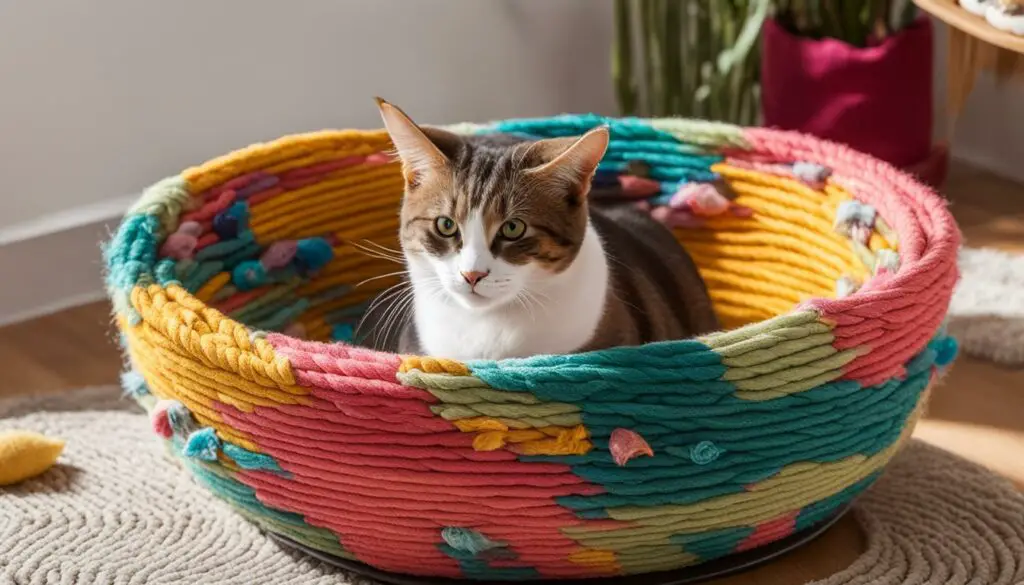
“Investing in these essential cat accessories will contribute to your cat’s happiness and overall quality of life.”
Conclusion
In conclusion, choosing the right bowls for your cat is crucial for their safety and well-being. While ceramic bowls can be a viable option, it’s important to be aware of the potential risks associated with glazes and lead. Prioritizing non-toxic materials like glass and stainless steel is recommended to ensure your cat’s health.
When selecting cat bowls, consider factors such as material safety, durability, and ease of cleaning. Opt for non-toxic materials labeled as food safe, and avoid plastic bowls that may harbor harmful bacteria and chemicals. Remember to wash the bowls thoroughly after each use to maintain hygiene.
Additionally, it’s essential to provide your cat with high-quality food that contains the necessary nutrients for their well-being. Look for cat foods that prioritize meat as cats are obligate carnivores. Pet stores often offer higher quality options compared to big box stores, so keep this in mind when making your selection.
Finally, along with choosing the right bowls and food, consider other essential cat accessories that contribute to their happiness. Grooming tools, a scratching post, and a suitable litter box are all important components of a cat-friendly environment.
FAQ
Are ceramic bowls safe for cats?
Ceramic bowls can be a safe choice for cats, but it’s important to exercise caution. Look for ceramic bowls that are labeled “lead-free” and “food safe.” Avoid glazed ceramics that may contain toxic substances like lead and cadmium. Check for any chips or cracks that could increase the risk of ingestion.
What are the safest materials for cat food bowls?
Glass and stainless steel are considered the safest materials for cat food bowls. Glass is non-toxic, non-reactive, and can be sterilized. Stainless steel is impermeable, doesn’t hold germs, and is very durable. These materials are recommended over plastic due to the potential health risks associated with plastic bowls.
What are the dangers of plastic bowls for cats?
Plastic bowls should be avoided due to their potential health hazards. Plastic is porous, easily scratched, and can harbor bacteria. It may also contain harmful chemicals like BPA and phthalates, which can disrupt the endocrine system and lead to various health issues. Plastic bowls can also cause feline acne and skin allergies.
How should I clean cat bowls?
Regardless of the material used, it’s important to wash cat bowls thoroughly after each use with soap and water. Wet food bowls should be placed in the dishwasher at least 3-4 times per week or even daily to ensure proper sterilization. Keeping the bowls clean helps prevent the growth of bacteria and maintains your cat’s health.
What are some non-toxic alternatives to ceramic bowls?
Non-toxic alternatives to ceramic bowls include glass and stainless steel. These materials have been proven safe for cats and are recommended over plastic bowls. Look for pet dishes that are certified for food usage and avoid products that may contain harmful substances.
What are the benefits of ceramic pet dishes?
Ceramic pet dishes are durable, environmentally friendly, and can be non-toxic when made with lead-free glazes. They can be a safe option for feeding your cat, but it’s important to ensure the glaze used on the bowl doesn’t contain any lead.
Are stoneware pet bowls safe?
Stoneware pet bowls can be durable and long-lasting, but there have been concerns regarding lead levels in some products. Testing has shown that a significant percentage of stoneware pet products contain detectable levels of lead, which can exceed safety standards. It’s essential to research and choose stoneware bowls carefully.
What are silicone pet dishes?
Silicone pet dishes offer a non-toxic option for feeding your cat. They are nonstick, heat-resistant, and can be easily cleaned in the dishwasher. However, silicone dishes may not be as rigid as other materials, making them less suitable as permanent pet dishes.
Where can I find non-toxic pet dishes?
When searching for non-toxic pet dishes, it’s essential to do thorough research and choose reputable sources. Look for products that are certified for food usage and manufactured in the United States. Avoid products that may contain harmful substances and prioritize the safety of your cat.
What factors should I consider when choosing cat bowls?
When selecting cat bowls, consider factors such as material safety, durability, and ease of cleaning. Opt for non-toxic materials like glass or stainless steel, ensuring they are labeled as food safe. Pay attention to any potential hazards, such as lead glazes in ceramics, and choose bowls that suit your cat’s needs.
How important is the quality of cat food?
The quality of cat food plays a crucial role in your cat’s overall health and well-being. Look for cat foods that contain sufficient nutrients, especially meat, as cats are obligate carnivores. Higher quality cat foods are typically found in pet stores rather than big box stores, so consider this when making your selection.
What are essential cat accessories for a happy cat?
In addition to choosing the right food and bowls, there are other essential accessories that can contribute to your cat’s happiness. These include grooming tools like brushes and nail trimmers, a scratching post to satisfy natural instincts, and a suitable litter box with proper scooping and litter choices.
What is the conclusion regarding ceramic bowls for cats?
Choosing the right bowls for your cat is a critical decision that can impact their health and well-being. Ceramic bowls can be a safe choice when used correctly, but it’s important to be aware of potential risks associated with glaze and lead. Prioritize non-toxic materials like glass and stainless steel, and always prioritize the safety and comfort of your beloved feline companion.

